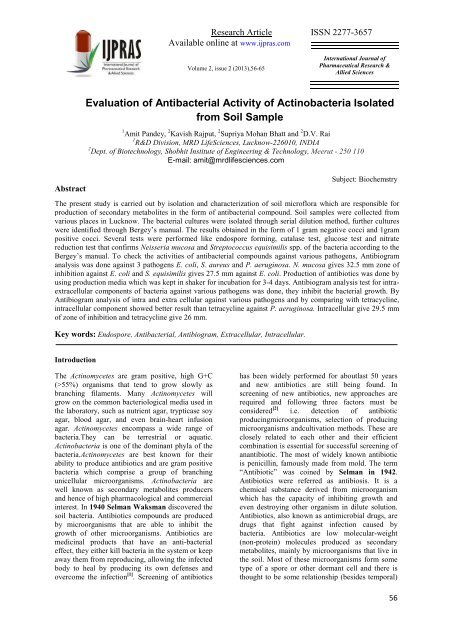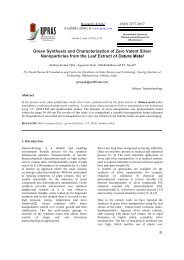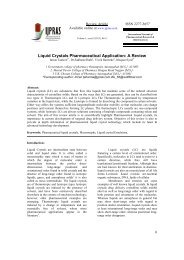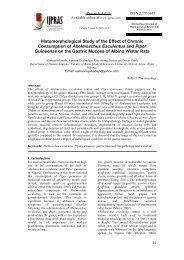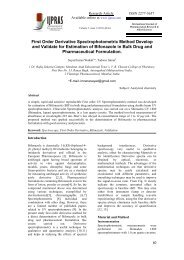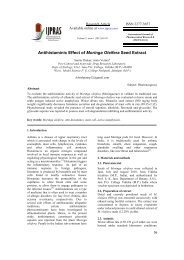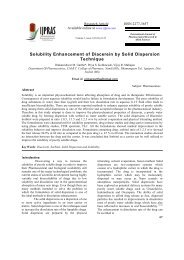evaluation of antibacterial activity of actinobacteria isolated from soil ...
evaluation of antibacterial activity of actinobacteria isolated from soil ...
evaluation of antibacterial activity of actinobacteria isolated from soil ...
You also want an ePaper? Increase the reach of your titles
YUMPU automatically turns print PDFs into web optimized ePapers that Google loves.
Research Article ISSN 2277-3657<br />
Available online at www.ijpras.com<br />
Volume 2, issue 2 (2013),56-65<br />
International Journal <strong>of</strong><br />
Pharmaceutical Research &<br />
Allied Sciences<br />
Abstract<br />
Evaluation <strong>of</strong> Antibacterial Activity <strong>of</strong> Actinobacteria Isolated<br />
<strong>from</strong> Soil Sample<br />
1 Amit Pandey, 2 Kavish Rajput, 2 Supriya Mohan Bhatt and 2 D.V. Rai<br />
1 R&D Division, MRD LifeSciences, Lucknow-226010, INDIA<br />
2 Dept. <strong>of</strong> Biotechnology, Shobhit Institute <strong>of</strong> Engineering & Technology, Meerut - 250 110<br />
E-mail: amit@mrdlifesciences.com<br />
Subject: Biochemstry<br />
The present study is carried out by isolation and characterization <strong>of</strong> <strong>soil</strong> micr<strong>of</strong>lora which are responsible for<br />
production <strong>of</strong> secondary metabolites in the form <strong>of</strong> <strong>antibacterial</strong> compound. Soil samples were collected <strong>from</strong><br />
various places in Lucknow. The bacterial cultures were <strong>isolated</strong> through serial dilution method, further cultures<br />
were identified through Bergey’s manual. The results obtained in the form <strong>of</strong> 1 gram negative cocci and 1gram<br />
positive cocci. Several tests were performed like endospore forming, catalase test, glucose test and nitrate<br />
reduction test that confirms Neisseria mucosa and Streptococcus equisimilis spp. <strong>of</strong> the bacteria according to the<br />
Bergey’s manual. To check the activities <strong>of</strong> <strong>antibacterial</strong> compounds against various pathogens, Antibiogram<br />
analysis was done against 3 pathogens E. coli, S. aureus and P. aeruginosa. N. mucosa gives 32.5 mm zone <strong>of</strong><br />
inhibition against E. coli and S. equisimilis gives 27.5 mm against E. coli. Production <strong>of</strong> antibiotics was done by<br />
using production media which was kept in shaker for incubation for 3-4 days. Antibiogram analysis test for intraextracellular<br />
components <strong>of</strong> bacteria against various pathogens was done, they inhibit the bacterial growth. By<br />
Antibiogram analysis <strong>of</strong> intra and extra cellular against various pathogens and by comparing with tetracycline,<br />
intracellular component showed better result than tetracycline against P. aeruginosa. Intracellular give 29.5 mm<br />
<strong>of</strong> zone <strong>of</strong> inhibition and tetracycline give 26 mm.<br />
Key words: Endospore, Antibacterial, Antibiogram, Extracellular, Intracellular.<br />
Introduction<br />
The Actinomycetes are gram positive, high G+C<br />
(>55%) organisms that tend to grow slowly as<br />
branching filaments. Many Actinomycetes will<br />
grow on the common bacteriological media used in<br />
the laboratory, such as nutrient agar, trypticase soy<br />
agar, blood agar, and even brain-heart infusion<br />
agar. Actinomycetes encompass a wide range <strong>of</strong><br />
bacteria.They can be terrestrial or aquatic.<br />
Actinobacteria is one <strong>of</strong> the dominant phyla <strong>of</strong> the<br />
bacteria.Actinomycetes are best known for their<br />
ability to produce antibiotics and are gram positive<br />
bacteria which comprise a group <strong>of</strong> branching<br />
unicellular microorganisms. Actinobacteria are<br />
well known as secondary metabolites producers<br />
and hence <strong>of</strong> high pharmacological and commercial<br />
interest. In 1940 Selman Waksman discovered the<br />
<strong>soil</strong> bacteria. Antibiotics compounds are produced<br />
by microorganisms that are able to inhibit the<br />
growth <strong>of</strong> other microorganisms. Antibiotics are<br />
medicinal products that have an anti-bacterial<br />
effect, they either kill bacteria in the system or keep<br />
away them <strong>from</strong> reproducing, allowing the infected<br />
body to heal by producing its own defenses and<br />
overcome the infection [1] . Screening <strong>of</strong> antibiotics<br />
has been widely performed for aboutlast 50 years<br />
and new antibiotics are still being found. In<br />
screening <strong>of</strong> new antibiotics, new approaches are<br />
required and following three factors must be<br />
considered [2] i.e. detection <strong>of</strong> antibiotic<br />
producingmicroorganisms, selection <strong>of</strong> producing<br />
microorganisms andcultivation methods. These are<br />
closely related to each other and their efficient<br />
combination is essential for successful screening <strong>of</strong><br />
anantibiotic. The most <strong>of</strong> widely known antibiotic<br />
is penicillin, famously made <strong>from</strong> mold. The term<br />
“Antibiotic” was coined by Selman in 1942.<br />
Antibiotics were referred as antibiosis. It is a<br />
chemical substance derived <strong>from</strong> microorganism<br />
which has the capacity <strong>of</strong> inhibiting growth and<br />
even destroying other organism in dilute solution.<br />
Antibiotics, also known as antimicrobial drugs, are<br />
drugs that fight against infection caused by<br />
bacteria. Antibiotics are low molecular-weight<br />
(non-protein) molecules produced as secondary<br />
metabolites, mainly by microorganisms that live in<br />
the <strong>soil</strong>. Most <strong>of</strong> these microorganisms form some<br />
type <strong>of</strong> a spore or other dormant cell and there is<br />
thought to be some relationship (besides temporal)<br />
56
Available online at www.ijpras.com<br />
between antibiotic production and the processes <strong>of</strong><br />
sporulation<br />
[3,4,5,6] . Soil are cheap sources <strong>of</strong><br />
antibiotics, many bacteria are present in <strong>soil</strong>. Many<br />
antibiotics produced via microorganisms.<br />
The present study is carried out by isolation,<br />
production and characterization <strong>of</strong> anti-bacterial<br />
compound <strong>from</strong> <strong>soil</strong> microbes <strong>of</strong> the <strong>soil</strong> sample.<br />
Methodology<br />
Collection <strong>of</strong> <strong>soil</strong> sample<br />
Soil samples were collected <strong>from</strong> Garden <strong>soil</strong> <strong>of</strong><br />
different places in Lucknow.<br />
• Indra Nagar<br />
• Aliganj<br />
Isolation <strong>of</strong> <strong>antibacterial</strong> compound producing<br />
bacteria <strong>from</strong> <strong>soil</strong><br />
Serial dilution:<br />
Serial dilution agar plating method or viable count<br />
method is one <strong>of</strong> the most commonly used<br />
procedures for the isolation and enrichment <strong>of</strong> the<br />
most prevalent micro-organism such as fungi,<br />
bacteria. This method is based on the principle that<br />
when sample containing the micro-organism is<br />
cultured, each viable micro-organism will develop<br />
into a colony; this method is used for reduced<br />
bacterial colonies in order to get pure cultures.<br />
Mixed culture- A culture plate containing two or<br />
more micro-organism is known as mixed culture.<br />
Procedure- Based on the work done by Jeffery [7] .<br />
Primary screening<br />
• After incubated overnight four types <strong>of</strong><br />
colonies were present in the plates.<br />
• Zone <strong>of</strong> inhibition around the colonies<br />
were observed.<br />
• Colonies showing zones <strong>of</strong> inhibition were<br />
selected for streaking and secondary<br />
screening.<br />
Sub culturing: Subculturing was done by streaking<br />
method.<br />
Pure culture: A pure culture is usually derived<br />
<strong>from</strong> a mixed culture (containing many species) by<br />
methods that separate the individual cells so that,<br />
when they multiply, each will form an individually<br />
distinct colony, which may then be used to<br />
establish new cultures with the assurance that only<br />
one type <strong>of</strong> organism will be present. Pure cultures<br />
may be more easily <strong>isolated</strong> if the growth medium<br />
<strong>of</strong> the original mixed culture favors the growth <strong>of</strong><br />
one organism to the exclusion <strong>of</strong> others.<br />
Staining and biochemical characterization <strong>of</strong><br />
sample<br />
Gram staining was performed to identify the<br />
culture according to Bergey’s manual [8] .<br />
Secondary screening<br />
Activity <strong>of</strong> biological compounds agent pathogen<br />
an important task <strong>of</strong> the clinical microbiology<br />
laboratory is the performance <strong>of</strong> <strong>antibacterial</strong><br />
susceptibility testing <strong>of</strong> significant bacterial<br />
isolates. The goals <strong>of</strong> testing are to detect possible<br />
drug resistance in common pathogens and to assure<br />
susceptibility to drugs <strong>of</strong> choice for particular<br />
infections.<br />
Endospore test and Catalase test were performed to<br />
identify the culture through Bergey’s manual [9, 10] .<br />
Screening test- for Streptococcus<br />
6.5% NaCl test, Acid production <strong>from</strong> glycerol test,<br />
OF glucose test, Nitrate test were performed to<br />
identify the culture and methods were used as par<br />
Aneja.<br />
Production <strong>of</strong> <strong>antibacterial</strong> compound by shake<br />
flask fermentation<br />
Fermentation- The process by which complex<br />
organic compounds, such as glucose, are broken<br />
down by the action <strong>of</strong> enzymes in to simpler<br />
compounds without the use <strong>of</strong> oxygen.<br />
Extraction <strong>of</strong> <strong>antibacterial</strong>compound <strong>from</strong><br />
Production media<br />
Centrifugation- It is a process that involves the<br />
use <strong>of</strong> the centrifugal force for the sedimentation <strong>of</strong><br />
mixtures with a centrifuge, used in industry and in<br />
laboratory settings. More-dense components <strong>of</strong> the<br />
mixture migrate away <strong>from</strong> the axis <strong>of</strong> the<br />
centrifuge, while less-dense components <strong>of</strong> the<br />
mixture migrate towards the axis. Chemists and<br />
biologists may increase the effective gravitational<br />
force on a test tube so as to more rapidly and<br />
completely cause the precipitate (pellet) to gather<br />
on the bottom <strong>of</strong> the tube. The remaining solution<br />
properly called the supernatant or supernatant<br />
liquid. The supernatant liquid is then either quickly<br />
decanted <strong>from</strong> the tube without disturbing the<br />
precipitate, or withdrawn with a pipette.<br />
Procedure:<br />
After incubation production media is transferred to<br />
6 centrifuge tubes (5 ml each). The tubes were<br />
centrifuge at 10,000 rpm for 10 min. After<br />
centrifugation, store supernatant and pellets.<br />
Supernatant is extracellular component and pellet is<br />
intracellular component.<br />
Extraction <strong>of</strong> intracellular compound<br />
Solvent extraction is a method for processing<br />
materials by using a solvent to separate out<br />
variables components with a material sample.<br />
57
Available online at www.ijpras.com<br />
Extraction <strong>of</strong> extracellular compound by solvent<br />
extraction method<br />
Antibiotic sensitivity test<br />
Antibiotic sensitivity test is done to check the<br />
<strong>activity</strong> <strong>of</strong> antibiotic against pathogens.<br />
Antibiotic: chemical compounds produce by<br />
microorganisms or a similar product produce<br />
wholly (synthetic) or partially (semi-synthetic) by<br />
chemical synthesis that inhibit growth or kill other<br />
microorganisms.<br />
Antibiotic sensitivity: is a term used to describe the<br />
susceptibility <strong>of</strong> bacteria to antibiotics. Antibiotic<br />
sensitivity testing (AST) is usually carried out to<br />
determine which antibiotic will be most successful<br />
in treating a bacterial infection in vivo.<br />
Study <strong>of</strong> growth kinetics<br />
Growth is an orderly increase in the quantity <strong>of</strong><br />
cellular constituents. It depends upon the ability <strong>of</strong><br />
the cell to form new protoplasm <strong>from</strong> nutrients<br />
available in the environment. In most bacteria,<br />
growth involves increase in cell mass and number<br />
<strong>of</strong> ribosome, duplication <strong>of</strong> the bacterial<br />
chromosome, synthesis <strong>of</strong> new cell wall and plasma<br />
membrane, partitioning <strong>of</strong> the two chromosomes,<br />
septum formation, and cell division. This asexual<br />
process <strong>of</strong> reproduction is called binary fission.<br />
Lag Phase, Log Phase, Stationary Phase and Death<br />
Phase.<br />
Antibiogram analysis<br />
An antibiogram is the result <strong>of</strong> a laboratory testing<br />
for the sensitivity <strong>of</strong> an <strong>isolated</strong> bacterial strain to<br />
different antibiotics. Once a culture is established,<br />
there are two possible ways to get an Antibiogram:<br />
Kirby-Bauer antibiotic testing (KB testing or disk<br />
diffusion antibiotic sensitivity testing) [11] is a test<br />
which use antibiotic impregnated wafers to test<br />
whether particular bacteria are susceptible to<br />
specific antibiotics. A known quantity <strong>of</strong> bacteria is<br />
grown on agar plates in the presence <strong>of</strong> thin wafers<br />
containing relevant antibiotics. If the bacteria are<br />
susceptible to a particular antibiotic, an area <strong>of</strong><br />
clearing surrounds the water where bacteria are not<br />
capable <strong>of</strong> growing(called a zone <strong>of</strong> inhibition).<br />
Procedure:<br />
Prepare 50ml NA media and autoclave, after<br />
autoclaving <strong>of</strong> glass wear and media are taken in<br />
LAF. The media is poured in 3 petriplates and left<br />
for solidification, after solidification <strong>of</strong> media,<br />
spread 50µl <strong>of</strong> 3 pathogens (E. coli, S. aureus & P.<br />
aeruginosa) in three petriplates. Then prepare the<br />
wells with the help <strong>of</strong> sterile borer and load the first<br />
well by extracellular component, second well by<br />
intracellular component and third well by<br />
tetracycline. Incubate at 37 0 C for overnight.<br />
Results<br />
Isolation and screening <strong>of</strong> antibiotic producing<br />
microorganism<br />
Microbes <strong>from</strong> <strong>soil</strong> were <strong>isolated</strong> by serial dilution<br />
method and mixed culture was obtained by<br />
spreading as shown in figure:<br />
Figure 1: Mixed colonies in spread plate.<br />
Table 1: Colony morphology <strong>of</strong> culture <strong>from</strong> sample C1, C2, C3 and C4.<br />
58
Available online at www.ijpras.com<br />
Colony<br />
morphology<br />
Shape<br />
Margin<br />
Opacity<br />
Pigmentation<br />
Culture C1 Culture C2 Culture C3<br />
Circular Circular Circular<br />
Entire Entire Entire<br />
Translucent Translucent Opaque<br />
White Off white Off white<br />
Culture C4<br />
Circular<br />
Entire<br />
Opaque<br />
Off white<br />
Sub Culturing<br />
The cultures C1, C2, C3 and C4 obtain through primary screening were purified by zigzag or simple streaking<br />
was shown in fig. 2:<br />
C1<br />
C2<br />
C3<br />
C4<br />
Fig 2: Pure colonies obtained through simple streaking<br />
C3 and C4 pure colonies obtained through Quadrant Streaking.<br />
C3<br />
C4<br />
Fig 3:- Pure colonies obtained through Quadrant streaking.<br />
59
Available online at www.ijpras.com<br />
Gram’s Staining Result<br />
After gram’s staining slide were observed under<br />
microscope and some colonies (C1, C2, C3) get pink<br />
colour and some get purple colour (C4). The colonies<br />
showing pink colour are gram negative cocci and<br />
colony which shows purple colour are gram positive<br />
cocci bacteria.<br />
Antibiogram Analysis<br />
Antibiogram <strong>of</strong> purified cultures C1, C2, C3 and<br />
C4 was performed against various pathogens (E.<br />
coli, P. aeruginosa and S. aureus). There were<br />
zones <strong>of</strong> inhibition obtained in each culture. Each<br />
cultures show positive result against pathogens.<br />
E. coli S. aureus<br />
P. aeruginosa<br />
Fig 4: Antibiogram analysis <strong>of</strong> cultures against various pathogens.<br />
Table 2: Antibiogram <strong>of</strong> <strong>isolated</strong> cultures against various pathogens<br />
S. No. Pathogens Culture C1<br />
Diameter (mm)<br />
Culture C2<br />
Diameter (mm)<br />
Culture C3<br />
Diameter (mm)<br />
Culture C4<br />
Diameter (mm)<br />
1 E. coli 10 10 0 8<br />
2 S. aureus 10 0 9 0<br />
3 P. aeruginosa 10 10.5 0 9<br />
Endospore test result:<br />
The pink colour was observed for Cocci under<br />
microscope, which confirms that these are nonendospore<br />
forming bacteria.<br />
Catalase test:<br />
In this test bubble formation was not observed. By this<br />
we confirmed that the bacteria are <strong>from</strong> group<br />
Streptococcus.<br />
6.5% NaCl test:<br />
No growth was observed in 6.5% NaCl. Therefore,<br />
further glycerol test was done to confirm the species <strong>of</strong><br />
Streptococcus.<br />
Acid <strong>from</strong> glycerol test:<br />
After 72 hrs appearance <strong>of</strong> yellow halo surrounding the<br />
streak was appeared showing that these gram positive<br />
bacteria are producing acid, which confirmed<br />
Streptococcus equisimilis species.<br />
60
Available online at www.ijpras.com<br />
Fig 5:- Gram positive bacteria are producing acid<br />
OF glucose test:<br />
After performing this test blue colour <strong>of</strong> the solution changes to yellow due to glucose fermentation and confirm<br />
Neisseria group.<br />
Blank<br />
Test sample<br />
Fig 6:- Showing glucose fermentation<br />
Nitrate test:<br />
This test is done to confirm the species <strong>of</strong> Neisseria. In this test the red colour <strong>of</strong> solution was observed which<br />
shows that nitrate was reduced and confirmed Neisseria mucosa species.<br />
Initial colour<br />
Final colour showing nitrate reduced<br />
Fig 7:- Showing Nitrate reduction.<br />
Antibiogram <strong>of</strong> intracellular and extracellular antibiotic extract:<br />
Antibiogram analysis <strong>of</strong> intra-extracellular <strong>from</strong> sample C3 and C4 was performed against various pathogens.<br />
61
Available online at www.ijpras.com<br />
Table 3: Antibiogram analysis <strong>of</strong> intra-extracellular antibiotic extract <strong>from</strong> N. mucosa<br />
S. No. Pathogens Intracellular<br />
Diameter (mm)<br />
Extracellular<br />
Diameter (mm)<br />
Intra + Extra<br />
Diameter (mm)<br />
1 E. coli 0 32.5 27.5<br />
2 S. aureus 14.5 32.5 29<br />
3 P. aeruginosa 14.5 29 29<br />
E. coli S. aureus<br />
P. aeruginosa<br />
Fig 8: Antibiogram <strong>of</strong> intracellular and extracellular antibiotic extract <strong>from</strong> N. mucosa<br />
For S. equisimilis<br />
Table 4: Antibiogram analysis <strong>of</strong> intra-extracellular antibiotic extract <strong>from</strong> S. equisimilis<br />
S. No. Pathogens Intracellular<br />
Diameter (mm)<br />
Extracellular<br />
Diameter (mm)<br />
Intra + Extra<br />
Diameter (mm)<br />
1 E. coli 27.5 0 22<br />
2 S. aureus 18 0 12.5<br />
3 P. aeruginosa 19 0 20<br />
E. coli S. aureus<br />
P. aeruginosa<br />
Fig 9:- Antibiogram for <strong>of</strong> intracellular and extracellular antibiotic extract <strong>from</strong> S. equisimilis<br />
62
Available online at www.ijpras.com<br />
Table 5: Growth Kinetics <strong>of</strong> S. equisimilis<br />
Days O.D <strong>of</strong> the Culture Growth Phase<br />
1 0.77 Lag<br />
2 1.03 Log<br />
3 1.05 Log<br />
4 1.03 Stationary<br />
5 1 Stationary<br />
6 0.89 Decline<br />
7 0.84 Decline<br />
8 0.5 Decline<br />
O.D<br />
1.5<br />
1<br />
0.5<br />
0<br />
0 No. <strong>of</strong> days 5 10<br />
Fig 10: Growth Kinetics <strong>of</strong> S. equisimilis<br />
Table 7: Growth Kinetics <strong>of</strong> N. mucosa<br />
Days O.D <strong>of</strong> the Culture Growth Phase<br />
1 0.24 Lag<br />
2 0.57 Log<br />
3 0.95 Log<br />
4 0.94 Stationary<br />
5 0.93 Stationary<br />
6 0.87 Decline<br />
7 0.83 Decline<br />
O.D<br />
1.2<br />
1<br />
0.8<br />
0.6<br />
0.4<br />
0.2<br />
0<br />
0 5 10<br />
No. <strong>of</strong> days<br />
Fig 11: Growth Kinetics <strong>of</strong> N. mucosa<br />
63
Available online at www.ijpras.com<br />
Antibiogram Analysis<br />
Table 8: Antibiogram analysis <strong>of</strong> intra and extra cellular antimicrobial extract against various pathogens<br />
S. No. Pathogens Tetracycline<br />
(mm)<br />
Intracellular<br />
(mm)<br />
Intra-extra mixture<br />
(mm)<br />
1 E. coli 41 24 16.5<br />
2 P. aeruginosa 26 29.5 22<br />
3 S. aureus 35 25 23<br />
E. coli P. aeruginosa<br />
Discussion<br />
S. aureus<br />
Fig 12: Antibiogram analysis <strong>of</strong> culture sample against various pathogens<br />
Screening <strong>of</strong> antibiotics has been widely performed for<br />
about last 50 years and new antibiotics are still being<br />
found. In screening <strong>of</strong> new antibiotics, new approaches<br />
are required and following three factors must be<br />
considered i.e. detection <strong>of</strong> antibiotic producing<br />
microorganisms, selection <strong>of</strong> producing<br />
microorganisms and cultivation methods. Isolation <strong>of</strong><br />
microbes by serial dilution method is done. Soil<br />
sample is collected <strong>from</strong> various places in<br />
Lucknow [12,13,14] . Gram’s staining gives purple colour<br />
and pink colour bacteria and distinguish between gram<br />
positive and gram negative bacteria. Three gram<br />
negative cocci and one gram positive cocci are <strong>isolated</strong>.<br />
Several tests are done like Endospore forming, Catalase<br />
test , OF glucose test and Nitrate reduction test that<br />
confirms Neisseria mucosa and Streptococcus<br />
equisimilis spp. <strong>of</strong> the bacteria according to the<br />
Bergey’s manual. To check the activities <strong>of</strong><br />
antimicrobial compounds against various pathogens<br />
Antibiogram analysis is done. Pathogens used are E.<br />
coli, S. aureus and P. aeruginosa. Antibiogram analysis<br />
<strong>of</strong> antimicrobial compounds against various pathogens<br />
gives good result. N. mucosa gives 32.5 mm zone <strong>of</strong><br />
inhibition against E. coli and S. equisimilis gives 27.5<br />
mm against E. coli. Production <strong>of</strong> antibiotics was done<br />
by using production media which was kept in shaker<br />
for incubation for 3-4 days. Than Antibiogram analysis<br />
test for intra-extracellular components <strong>of</strong> bacteria<br />
against various pathogens is done. Antibiogram<br />
analysis <strong>of</strong> intra-extracellular component showed very<br />
good result, they inhibit the bacterial growth. The study<br />
<strong>of</strong> bacterial growth kinetics for <strong>isolated</strong> bacteria is<br />
done. After 3-5 days log phase is observed in every<br />
sample and after 5-6 days stationary and decline phase<br />
are found in bacterial growth. S shape curve (sigmoid)<br />
found in each samples.<br />
By Antibiogram analysis <strong>of</strong> intra and extra cellular<br />
against various pathogens and by comparing with<br />
tetracycline, intracellular componentshows better result<br />
than tetracycline against P. aeruginosa. Intracellular<br />
give 29.5 mm <strong>of</strong> zone <strong>of</strong> inhibition and tetracycline<br />
give 26 mm.<br />
Conclusion<br />
Screening <strong>of</strong> antibiotics has been widely performed for<br />
about last 50 years and new antibiotics are still being<br />
found. In screening <strong>of</strong> new antibiotics, new approaches<br />
are required and following three factors must be<br />
64
Available online at www.ijpras.com<br />
considered i.e. detection <strong>of</strong> antibiotic producing<br />
microorganisms, selection <strong>of</strong> producing<br />
microorganisms and cultivation methods.<br />
Finally it can be concluded that the Actinomycetes<br />
are the best source for antibiotic isolation.<br />
In this work by Antibiogram analysis intracellular<br />
component shows better result than tetracycline against<br />
P. aeruginosa. Intracellular give 29.5 mm <strong>of</strong> zone <strong>of</strong><br />
inhibition and tetracycline give 26 mm.<br />
As the antibiotics are secondary metabolites, they are<br />
synthesized in trace amounts. Moreover the synthesis <strong>of</strong><br />
antibiotic is regulated by tight metabolic and genetic<br />
regulation. Therefore it is the task to the<br />
biotechnologists to modify the wild type strain and to<br />
provide cultural conditions to improve the productivity<br />
<strong>of</strong> antibiotics. Improvement <strong>of</strong> the microbial strain<br />
<strong>of</strong>fers the greatest opportunity for cost reduction<br />
without significant capital investment. The problem <strong>of</strong><br />
the bacterial resistance to antibiotics had evolved and<br />
new compounds or derived <strong>from</strong> the known antibiotics<br />
had to be found to replace existing ones. Water and air<br />
microbes can also be used for the isolation,<br />
characterizing, purification and production <strong>of</strong><br />
antimicrobial compound.<br />
Future aspects<br />
In this project further more studies can be done.<br />
Antimicrobial compounds producing microbes are<br />
<strong>isolated</strong> and characterized and for purification <strong>of</strong> the<br />
antimicrobial compounds several techniques like TLC<br />
(Thin layer chromatography), air exposure method and<br />
HPLC can be done. Before launching the product in the<br />
market, the minimum quantity at which the drug or<br />
product works better should be known. For this MIC is<br />
done. MIC is the lowest concentration <strong>of</strong> an<br />
antimicrobial that inhibits the visible growth <strong>of</strong> a<br />
microorganism after incubation. Minimum inhibitory<br />
concentrations are important in diagnostic laboratory to<br />
confirm resistance <strong>of</strong> microorganism to an<br />
antimicrobial agent and also to monitor the <strong>activity</strong> <strong>of</strong><br />
new antimicrobial agents.<br />
Acknowledgement<br />
I wish to express my immense gratitude to Mr.<br />
Manoj Verma, Director, MRD LifeSciences (P)<br />
Limited, Lucknow. I am very grateful and my<br />
heartiest thanks to Mr. R.P. Mishra (Research<br />
Scientist) & Mr. Jahir Alam Khan (Research<br />
Scientist), MRDLS, Lucknow, for there kind<br />
support throughout the research work. I am also<br />
thankful to the almighty without whose blessings<br />
nothing was possible.<br />
“Cite this article”<br />
A.Pandey, K. Rajput, S.M.Bhatt D.V. Rai “Evaluation<br />
<strong>of</strong> Antibacterial Activity <strong>of</strong> Ctinobacteria Isolated <strong>from</strong><br />
Soil Sample” Int. J. <strong>of</strong> Pharm. Res. & All. Sci.2013;<br />
Volume 2, Issue 2,56-65<br />
References:<br />
(1) Alanis AJ .2005. Resistance to antibiotics: are<br />
we in the post-antibiotic era Archives <strong>of</strong><br />
MedicalResearch 36.697-705.<br />
(2) Enright MC.2003. The evolution <strong>of</strong> a resistant<br />
pathogen-the case <strong>of</strong> MRSA.Current Opinion in<br />
Pharmacology 3 (5), 474-479.<br />
(3) Hiramatsu K .1998. Vancomycin resistance in<br />
Staphylococci. Drug Resist Updates 1.135-150.<br />
(4) Bozdogan B., Esel D., Whitener C.2003.<br />
Antibacterial susceptibility <strong>of</strong> a vancomycin<br />
resistant Staphylococcus aureus strain <strong>isolated</strong><br />
at the Hershey Medical Center. Journal <strong>of</strong><br />
Antimicrobial Chemotherapy 52.864-868.<br />
(5) Anonymous.2004.Brief report: vancomycinresistant<br />
Staphylococcus aureus-New York.<br />
MMWR 53.322-323.<br />
(6) Chang S., Sievert DM, Hageman JC.<br />
2003.Infection with vancomycin resistant<br />
Staphylococcus aureuscontaining the vanA<br />
resistance gene. The New England Journal <strong>of</strong><br />
Medicine, 348, 1342- 1347.<br />
(7) Jeffrey, L. S. H.2008. Isolation, characterization<br />
and identification <strong>of</strong> Actinomycetes <strong>from</strong><br />
agriculture <strong>soil</strong>s at Semongok, Sarawak, African<br />
Journal <strong>of</strong> Biotechnology, 7 (20):3697-3702.<br />
(8) Kawato, M., Shinobu., R.1959. A simple<br />
technique for the microscopical observation,<br />
memoirs <strong>of</strong> the Osaka University Liberal Arts<br />
and Education.114.<br />
(9) Bergey’s manual <strong>of</strong> determinative<br />
bacteriology.2000. Actinomycetales. 9th<br />
edition.<br />
(10) Aneja.KR, Experiments in Microbiology,<br />
Plant Pathology and Biotechnology, New age<br />
International (P) Limited,Volume 4 th ,2003, 1-<br />
604.<br />
(11) Bauer,AW,Kirby, WM, Sheries, JC, Turck,M,<br />
Antibiotic susceptibility testing by a<br />
Standardized single disc method.<br />
AmJclinPathol, 1966, 45:149-158.<br />
(12) Bushell M. E., Smitht v and Lynchs<br />
H.C.,1997. A physiological model for the<br />
control <strong>of</strong> erythromycin production in batch and<br />
cyclic fed batch culture. Microbiology.<br />
143.475-480.<br />
(13) Hugh R., Ryschenkow E. 1961.Pseudomonas<br />
maltophilia, an alcaligenes-like species.<br />
Journal <strong>of</strong> General Microbiology 26.123-132.<br />
(14) Jevitt LA., Smith AJ., Williams PP., Raney<br />
PM., McGowan JE., Tenover FC. 2003.In<br />
vitro activities <strong>of</strong> daptomycin, linezolid, and<br />
quinupristin-dalfopristin against a challenge<br />
panel <strong>of</strong> Staphylococci and Enterococci,<br />
including<br />
vancomycin-intermediate<br />
Staphylococcus aureusand vancomycinresistant<br />
Enterococcus faecium.Microbial Drug<br />
Resistance .9.389-393.<br />
65


